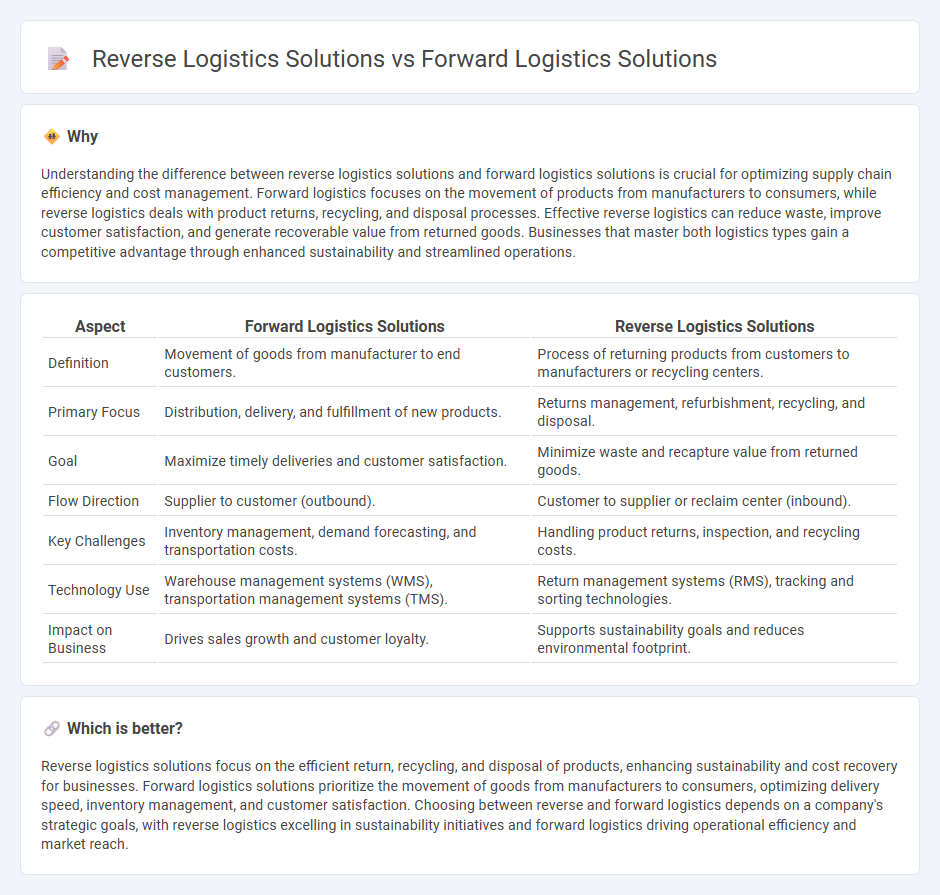
Reverse logistics solutions focus on the efficient return, recycling, and disposal of products, aiming to minimize waste and recover value. Forward logistics solutions involve the traditional flow of goods from manufacturers to consumers, emphasizing inventory management, distribution, and timely delivery. Explore how leveraging both reverse and forward logistics can optimize supply chain performance and sustainability.
Why it is important
Understanding the difference between reverse logistics solutions and forward logistics solutions is crucial for optimizing supply chain efficiency and cost management. Forward logistics focuses on the movement of products from manufacturers to consumers, while reverse logistics deals with product returns, recycling, and disposal processes. Effective reverse logistics can reduce waste, improve customer satisfaction, and generate recoverable value from returned goods. Businesses that master both logistics types gain a competitive advantage through enhanced sustainability and streamlined operations.
Comparison Table
| Aspect | Forward Logistics Solutions | Reverse Logistics Solutions |
|---|---|---|
| Definition | Movement of goods from manufacturer to end customers. | Process of returning products from customers to manufacturers or recycling centers. |
| Primary Focus | Distribution, delivery, and fulfillment of new products. | Returns management, refurbishment, recycling, and disposal. |
| Goal | Maximize timely deliveries and customer satisfaction. | Minimize waste and recapture value from returned goods. |
| Flow Direction | Supplier to customer (outbound). | Customer to supplier or reclaim center (inbound). |
| Key Challenges | Inventory management, demand forecasting, and transportation costs. | Handling product returns, inspection, and recycling costs. |
| Technology Use | Warehouse management systems (WMS), transportation management systems (TMS). | Return management systems (RMS), tracking and sorting technologies. |
| Impact on Business | Drives sales growth and customer loyalty. | Supports sustainability goals and reduces environmental footprint. |
Which is better?
Reverse logistics solutions focus on the efficient return, recycling, and disposal of products, enhancing sustainability and cost recovery for businesses. Forward logistics solutions prioritize the movement of goods from manufacturers to consumers, optimizing delivery speed, inventory management, and customer satisfaction. Choosing between reverse and forward logistics depends on a company's strategic goals, with reverse logistics excelling in sustainability initiatives and forward logistics driving operational efficiency and market reach.
Connection
Reverse logistics solutions and forward logistics solutions are interconnected through the continuous flow of goods, information, and resources, enabling efficient return, reuse, and redistribution processes. Effective integration of inventory management, transportation, and warehouse operations ensures seamless product lifecycle management from delivery to return or recycling. Data analytics and real-time tracking systems optimize decision-making for both forward shipments and reverse returns, enhancing supply chain sustainability and cost-efficiency.
Key Terms
**Forward Logistics Solutions:**
Forward logistics solutions streamline the movement of goods from manufacturers to customers, ensuring efficient order fulfillment, inventory management, and timely delivery through optimized transportation and warehousing systems. Key components include supply chain coordination, demand forecasting, and distribution network design to minimize costs and enhance customer satisfaction. Discover how forward logistics solutions can transform your supply chain efficiency and drive business growth.
Order Fulfillment
Forward logistics solutions streamline order fulfillment by ensuring efficient inventory management, timely product delivery, and accurate order processing, which enhances customer satisfaction and operational efficiency. Reverse logistics solutions focus on managing returns, refurbishments, and recycling, enabling companies to handle order discrepancies and product recalls effectively while reducing waste. Discover how optimizing both forward and reverse logistics can transform your order fulfillment capabilities.
Transportation Management
Forward logistics solutions streamline transportation management by optimizing routes, carrier selection, and shipment tracking to ensure timely delivery of goods from manufacturers to customers. Reverse logistics solutions focus on the efficient return, refurbishment, recycling, or disposal of products, emphasizing cost reduction and sustainability within transportation processes. Explore detailed strategies to enhance both forward and reverse transportation management for improved overall supply chain efficiency.
Source and External Links
Forward logistics: what it is and how it differs from reverse logistics - Forward logistics solutions focus on the movement of goods from seller to buyer with emphasis on speed, accuracy, and accountability, including same-day fulfillment, strategic warehouse locations, and expedited shipping to improve customer experience.
Forward Logistics Solutions - A Saudi Arabia-based freight forwarder offering global door-to-door shipping of time-sensitive documents and parcels with air, sea, and ground transportation options tailored for domestic and international logistics needs.
FAST FORWARD LOGISTICS SOLUTIONS - Provides a broad range of logistics services including air and sea freight export/import, global transport, customs clearance, supply chain visibility, warehousing, and IT solutions, emphasizing reliability and worldwide network support.
 dowidth.com
dowidth.com